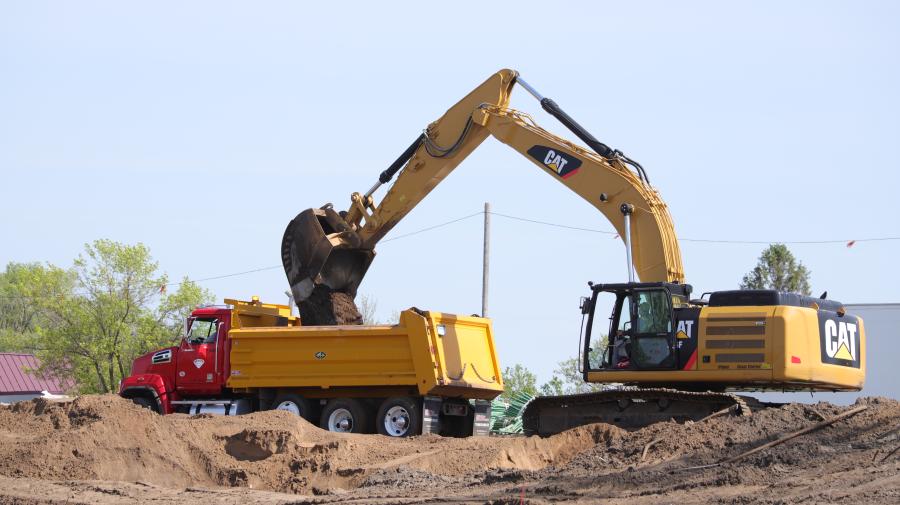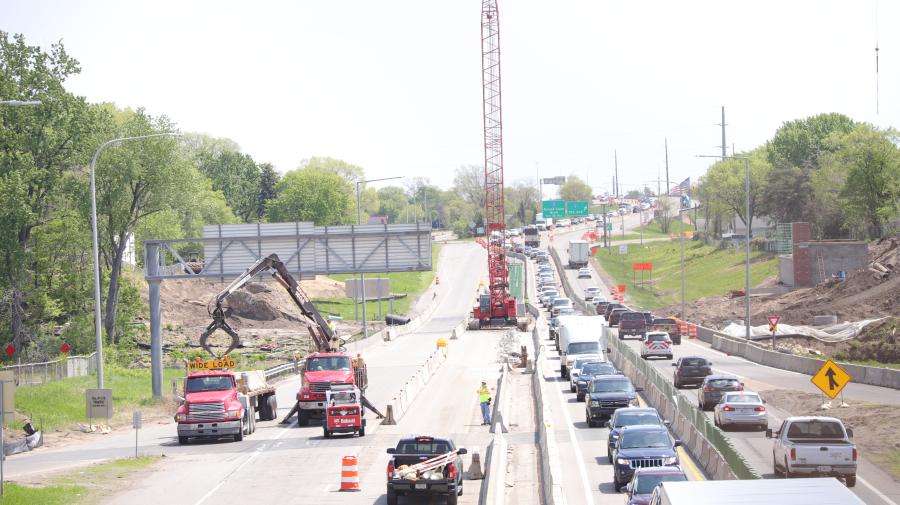Residents of Anoka, Minn., are on a winter hiatus from a two-year, $85 million project that includes a major state highway rebuild.
(Dick Rohland photo)
Residents of Anoka, Minn., are on a winter hiatus from a two-year, $85 million project that includes a major state highway rebuild that has a particular nasty bite to it because of the complexity of the local street network, very tight workspace and detailed traffic control. At times, homeowners and businesses found heavy equipment literally operating at their doorsteps.
Work is taking place on a 1.5-mi. section of HWY-10 that bisects the city of Anoka, a densely populated community of 18,000 residents located 15 mi. north of the Twin Cities of St. Paul/Minneapolis.
Shafer Contracting, headquartered in Shafer, Minn., is the prime contractor on this project. Lunda Construction, Black River Falls, Wis., is subcontracted by Shafer to rebuild the highway bridges. Bolten-Menk, based in Mankato, Minn., is the design consultant for the city of Anoka. The managing partners in this project are the Minnesota Department of Transportation (MnDOT), the city of Anoka and Anoka County.
The existing highway through this stretch of pavement is a signalized expressway where homes, businesses and three cemeteries sit within feet of the four-lane highway. It is now undergoing reconstruction to convert it to a freeway.
Not only will the finished mainline road be safer and more efficient, it will greatly improve connections from one side of the highway to the other, which in the past has been slow and cumbersome.
The HWY-10 corridor through the city of Anoka has been studied numerous times since the 1990's, resulting in no actual change due to the high price tag and lack of shared vision between the city and the state. In 2013, MnDOT completed a study of this corridor that achieved regional needs while providing community improvements that were supported by all partners. After the study was completed, the city of Anoka engineering staff realized they needed to lead the project.
"Our focus was to develop a singular vision all parties could support and develop a funding plan to realize these improvements," said Ben Nelson, assistant city engineer of the city of Anoka. "In just two years, all funding was secured through continuous advocacy, numerous competitive awards and commitments from project partners. With the city leading the project, the community's values are prominently featured in the design."
"One unique aspect here is this project never would have happened without the city taking a leadership role and delivering the largest, city-led project on the state highway network," said Eric Johnson of Bolten-Menk.
Coinciding with the current project, there is a major MnDOT road project nearby.
"To the public, there is one major project going on which is a testament to the close coordination the city and state had in the development of these two, major adjacent projects," Johnson said.
Through the years, accumulating accidents, severe traffic back-ups and dwindling traffic capacity were on the rise and made this project on MnDOT's list a priority. According to the city of Anoka web site, the accident rate on this highway is one and a half times the state average compared to other, similar highways.
The design issues were huge on this project, primarily centered on adding more capacity to the highway and improving local access for residential and commercial traffic for the city of Anoka.
Bolten-Menk and Anoka engineers laid out a detailed plan that all agencies agreed to and was coordinated with the nearby MnDOT project to the east to always maintain reasonable access to the community.
Three busy and high-volume arterial streets cross this section of highway within a very short distance
"HWY-10 is a barrier in the community," said Johnson. "It takes a long time for folks to cross or traverse the highway during peak hours. This barrier effect is greater than most due to the Mississippi River being immediately south and the BNSF Railway being immediately north, thus not leaving many options to cross those other barriers."
Preliminary engineering studies for this plan included an underground study of the three cemeteries that line both sides of the highway including one that dates to the 1850's. To minimize risk in construction, "we used ground penetrating radar around the perimeters of the cemeteries to identify any anomalies," Johnson said.
On the construction side, the existing highway will be removed and completely rebuilt along with three new interchanges and local street improvements. New storm and sanitary sewer are part of the construction package.
To make this all happen, the highway was reduced to one lane each direction to stage the construction and free up space for construction crews to work safely on the other lanes.
Construction quantities going into this project offer a clue to the intensity of the work that crews faced.
Fill, excavation, sewer and paving quantities lead this list with 298,700 cu. yds. going into embankment and 218,100 cu. yds. of excavated soil coming out. Nearly 2,800 cu. yds. of structural concrete will be placed, and 30,000 ft. of storm sewer will eventually be buried under the new pavement.
Equipment scattered throughout the work zone includes Cat, John Deere, Komatsu and Bomag heavy equipment. Terex and Manitowoc cranes and Grove lifts are on site for the bridge work.
Affecting residents directly, much of the work will zero in on improving the Thurston Avenue, Fairoak Avenue and Main Street crossings and connections of the highway.
Improvements at these highway connections include a new interchange at Thurston with a bridge to replace the existing, at grade signalized intersection.
The Fairoak Street connection with the highway will be removed and replaced with a new underpass.
The Main Street interchange will be reconstructed with roundabouts at the intersections to better control the transition from a freeway environment into downtown Anoka.
When construction finished for the season in late November, Shafer crews had met the major milestones.
Last August, the contractor discovered a safety issue that led to a quick reshuffling of the construction and traffic control phasing.
With Thurston Avenue scheduled to remain open to traffic through the first year of construction and nearby Fairoak Avenue closed, the contractor determined that the temporary clearance of 10.6 ft. of the new bridge at Thurston Avenue was too tight and not safe.
Because Fairoak Avenue was closed, the contractor proposed a rapid revision in the traffic and construction schedules.
"We didn't realize how tight [the clearance] was going to be until we're sitting there looking at it and ready to set the beams," said Chris Tredinnick, project manager of Shafer.
At this interchange, the original construction schedule called for further excavation of nearly 4 ft. under the HWY-10 bridge in 2023 to meet the standard clearance of 16 ft. and complete the construction of this interchange this year.
To resolve this safety concern, road crews temporarily closed Thurston Avenue in August to accommodate the newly proposed sequencing of the project.
"It was decided between the city and the contractor that it was in the best interest of the construction workers and the motorists to temporarily close Thurston at the same time as the Fairoak closure and move forward with the excavation under the new bridge last August to expedite the construction at Thurston Avenue," Tredinnick said. "There was no wiggle room in the schedule to have that kind of problem. You're at the end of summer, almost to the fall and you have this curve ball thrown at you. Once we realized there was a problem, we came up with and implemented a solution within a week. It was a substantial change in the overall schedule."
The other issue that popped up was a 48-in. sanitary pipe connection to the Metropolitan sewer system buried 30 ft. deep and originally planned to be jacked underground.
Once crews began jacking the pipe, they quickly ran into obstacles.
"It hit a lot of obstructions and we ended up having to cut it and make changes to the alignment." Tredinnick said.
Construction milestones include the completion of the new westbound HWY-10 bridge over Fairoak Avenue and the new eastbound HWY-10 bridge over Thurston Avenue.
When work resumes in the spring, crews will build the new westbound HWY-10 bridge over Thurston Avenue and the new eastbound HWY-10 bridge over Fairoak Avenue along with the remaining underground and paving work.
When substantial construction is completed this fall, highway capacity on this stretch of the road will rise from 60,600 vehicles per day to over 90,000 vehicles per day. CEG
Today's top stories



















